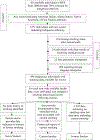Indigenous Smoking Behaviors in Olmsted County, Minnesota: A Longitudinal Population-Based Study
- PMID: 36202495
- PMCID: PMC9918799
- DOI: 10.1016/j.mayocp.2022.03.019
Indigenous Smoking Behaviors in Olmsted County, Minnesota: A Longitudinal Population-Based Study
Abstract
Objective: To describe smoking behaviors and pharmaceutical cessation aid uptake in a population-based Indigenous cohort compared with an age- and sex-matched non-Indigenous cohort.
Patients and methods: Using the health record-linkage system of the Rochester Epidemiology Project (January 1, 2006, to December 31, 2019), smoking data of Indigenous residents of Olmsted County in Minnesota were abstracted to define the smoking prevalence, incidence, cessation, relapse after cessation, and pharmaceutical smoking cessation aid uptake compared with a matched non-Indigenous cohort. Prevalence was analyzed with a modified Poisson regression; cessation and relapse were evaluated with generalized estimating equations. Incidence was evaluated with a Cox proportional hazards model.
Results: Smoking prevalence was higher in the Indigenous cohort (39.0% to 47.0%; n=898) than the matched cohort (25.6% to 30.3%; n=1780). Pharmaceutical uptake was higher among the Indigenous cohort (35.8% of n=584 ever smokers vs 16.3% of n=778 ever smokers; P<.001). Smoking cessation events occurred more frequently in the Indigenous cohort (relative risk, 1.10; 95% CI, 1.06 to 1.13; P<.001). Indigenous former smokers were more likely to resume smoking (relative risk, 3.03; 95% CI, 2.93 to 3.14; P<.001) compared with the matched cohort. These findings were independent of socioeconomic status, age, and sex.
Conclusion: Smoking in this Indigenous cohort was more prevalent compared with a sex- and age-matched non-Indigenous cohort despite more smoking cessation events and higher use of smoking cessation aids in the Indigenous cohort. The relapse rate after achieving cessation in the Indigenous cohort was more than three times higher than the non-Indigenous cohort. This finding has not been previously described and represents a potential target for relapse prevention efforts in US Indigenous populations.
Copyright © 2022 Mayo Foundation for Medical Education and Research. Published by Elsevier Inc. All rights reserved.
Conflict of interest statement
Conflict of Interest Disclosures:
Yvonne T. Bui and Jamie R. Felzer M.D., M.P.H have no disclosures to report.
Figures





Similar articles
-
Smoking Behaviors Among Indigenous Pregnant People Compared to a Matched Regional Cohort.Nicotine Tob Res. 2023 Apr 6;25(5):889-897. doi: 10.1093/ntr/ntac240. Nicotine Tob Res. 2023. PMID: 36250476 Free PMC article.
-
The incidence of central serous chorioretinopathy in Olmsted County, Minnesota, 1980-2002.Ophthalmology. 2008 Jan;115(1):169-73. doi: 10.1016/j.ophtha.2007.02.032. Ophthalmology. 2008. PMID: 18166410
-
Trends and predictors of smoking cessation after percutaneous coronary intervention (from Olmsted County, Minnesota, 1999 to 2010).Am J Cardiol. 2015 Feb 15;115(4):405-10. doi: 10.1016/j.amjcard.2014.11.020. Epub 2014 Nov 28. Am J Cardiol. 2015. PMID: 25541324
-
Smoking status and health care costs in the perioperative period: a population-based study.JAMA Surg. 2014 Mar;149(3):259-66. doi: 10.1001/jamasurg.2013.5009. JAMA Surg. 2014. PMID: 24382595 Free PMC article.
-
A review of the efficacy of smoking-cessation pharmacotherapies in nonwhite populations.Clin Ther. 2008 May;30(5):800-12. doi: 10.1016/j.clinthera.2008.05.010. Clin Ther. 2008. PMID: 18555928 Review.
Cited by
-
Racial Misclassification of American Indian and Alaska Native People in the Electronic Medical Record: An Unexpected Hurdle in a Retrospective Medical Record Cohort Study.J Med Internet Res. 2025 Jul 30;27:e73086. doi: 10.2196/73086. J Med Internet Res. 2025. PMID: 40737530 Free PMC article.
-
Identifying pragmatic solutions to reduce cigarette smoking prevalence in Indigenous North Americans: A sequential exploratory mixed-methods study protocol.PLoS One. 2024 Nov 11;19(11):e0306512. doi: 10.1371/journal.pone.0306512. eCollection 2024. PLoS One. 2024. PMID: 39527530 Free PMC article.
-
Smoking Behaviors Among Indigenous Pregnant People Compared to a Matched Regional Cohort.Nicotine Tob Res. 2023 Apr 6;25(5):889-897. doi: 10.1093/ntr/ntac240. Nicotine Tob Res. 2023. PMID: 36250476 Free PMC article.
References
-
- Centers for Disease Control and Prevention. American Indians/Alaska Native and Tobacco Use.
-
- United States Census. The American Indian and Alaska Native Population: 2010. 2010.
-
- Mowery PD, Dube SR, Thorne SL, Garrett BE, Homa DM, Nez Henderson P. Disparities in Smoking-Related Mortality Among American Indians/Alaska Natives. Am J Prev Med. 2015;49:738–744. - PubMed
-
- Brownson RC, Fielding JE, Maylahn CM. Evidence-based public health: a fundamental concept for public health practice. Annu Rev Public Health. 2009;30:175–201. - PubMed
Publication types
MeSH terms
Substances
Grants and funding
LinkOut - more resources
Full Text Sources
Medical

